Introduction
Edward Hopper is one of my favourite painters. And I must say that I am myself surprised to say so.
If you have read my previous articles, you will realise that I like it weird. After all, isn’t the whole point of this site to review and analyse bizarre works? Well, Hopper’s works aren’t bizarre, so why analysing them here?
For some reason I’ve still not fully comprehended, Hopper’s paintings have enchanted me from the moment I set eyes on them for the first time. This attraction was different from what I felt when appreciating a good surrealistic work, which is what I’m usually passionate about.
But clearly, Hopper isn’t a surrealist. His paintings are, in fact, quite realist – that’s his style, realism, which you may argue is quite the opposite of surrealism.
Nighthawks in particular looks like a rather mundane scene with few extraordinary elements that necessitate any exhaustive analysis. However, I have little doubt that most people feel there is simply something enigmatic about this painting.
In this article, I set my mind to exploring why that is.
Review
Nighthawks’ central element is a well-illuminated diner located just around the corner of an otherwise deserted and unlit street.
Inside the diner we see three customers and a waiter. One of the customers appears to be a middle-aged man seating alone and with a glass in his hand. The other two customers are a man and a woman seating next to each other but clearly lost in their own thoughts. The waiter is the more active of the four characters and appears to be cleaning or preparing a drink. Facial expressions are not sad, not happy, just tense, and apprehensive.
There is also a certain dynamism in Nighthawks; it’s almost as if we can witness not just quietude, but also motion inside the diner, as if a story is unfolding. This fits Hopper’s intention not to provide viewers with an explicit narrative, but encourage them to make one up themselves.
Technically, I find the painting to be of an ineffable mastery. Hopper was an incredibly meticulous painter; before embarking on any project, he would make innumerable sketches and studies of people, lighting, and perspective. I greatly admire this in painters and Nighthawks epitomises Hopper’s tenacity for producing few but superb quality works.
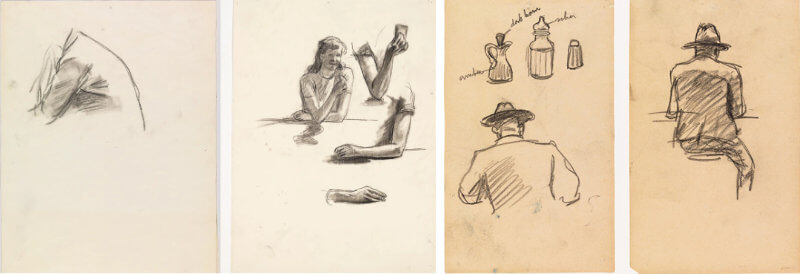
Fortunately, most of the preparatory material for Nighthawks has survived (at least 19 sketches, but probably many more existed) and give us vital clues about the artist’s working method.
The first thing to notice is that the painting is immaculate and very smooth; every stroke appears to have been purposefully placed on the canvas. This is the result of Hopper’s painstaking analysis and research on the subject matter, only transposing the elements onto the canvas once he was satisfied with the result of his studies.
Nothing was left to chance. In his sketches we can see how he approached some of the elements in Nighthawks, not neglecting any of them but giving them equal importance. For example, the hand of the woman, the distance between the couple, the back angle of the lonely man, the various objects on the counter, the coffee bins, the clothes, facial expressions have all been carefully studied by Hopper.
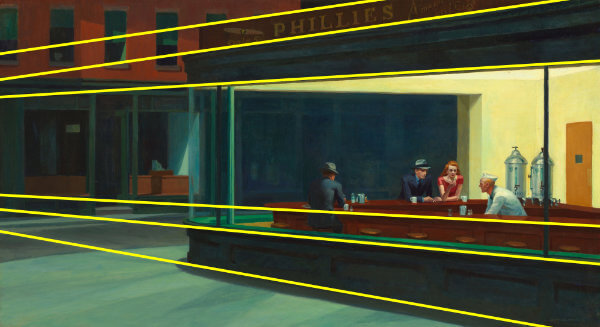
The second important aspect of Nighthawks is the way Hopper made use of perspective. Note the clever use of long diagonals lines and how they seem to converge somewhere off-canvas, giving it a feeling of continuity outside the painting. There is also a certain harmony in how these lines run “along” the lines of the counter so that the whole painting just feels right.
The perspective is from someone approaching the diner. It’s interesting there is no door, but a rather large window accentuated by the bright yellow lights. It is this combination (perspective + lighting) that seems to invite passers-by to inevitably peer, in a sort of voyeuristic interest, into the diner.
Finally, the lighting/colour contrast is particularly ingenious. It’s night outside, there are no street lamps or any source of illumination whatsoever. The only vestige of light outside the diner is the one emanating from the diner itself, timidly suffusing the outside street. Hopper achieved this by using darker and paler tones of red and green colours as opposed to vibrant and bright yellow in the interior of the diner.
The stark contrast of light and colour is, in my opinion, what produces the eerie mood that imbues most of Hopper’s paintings, Nighthawks inclusive.
Our rating
Oh boy, what a painting! Really, who would have thought that such a mundane painting of a diner would bring about so much feeling? Seriously, think about it: if you didn’t know Hopper and I told you of a painting of an all-night diner with four people inside, would that really have spiked your interest?
Hopper used everything in the right amount: number of elements, facial expressions, colour, shadow, perspective, lighting.
Despite depicting a few elements within a simple setting, the painting is full of contrasts: a daily and typical scene contrasted with an eerie atmosphere; vibrant colours in the diner contrasted with darkness in the street; lifeless outside the diner contrasted with alive elements inside of it; people physically close contrasted with tension among them, and so on. The viewer is quite cognizant of what he/she is seeing (really, a painting of an all-night diner), but is well aware that something is off.
And all of that without placing a single surreal element onto the canvas. Brilliant!
Of course, 5 stars!
Bizarrometer
This is an easy one: Nighthawks is not weird at all.
There are no surreal elements or elements out of place. Sure, there is a certain eeriness that I find indescribable really (which is the reason we are reviewing it) but there is nothing in the painting that requires explaining.
For this reason, Nighthawks gets a rating of 0.5 in the Bizarrometer.
Nighthawks (briefly) Explained!
Most interpretations I’ve read about this painting revolve around the idea that it represents human isolation. This interpretation gains credibility when we consider that Hopper painted it 1942, when the world was at the heist of the Second World War.
Rationing, longer working hours, millions of people overseas, and a general apprehension that war could be brought to the US meant that people restricted social events (e.g., frequented less diners) than they used to prior to the war. Furthermore, blackout drills were the norm in New York at the time, and lights were often dimmed in public spaces, further discouraging people from remaining outside for long hours at night.
However, Hopper emphasized that he did not purposefully infused this painting with themes of loneliness or emptiness, although he did acknowledge that “unconsciously, I [Hopper] was painting loneliness of a large city”.
He also is reported saying: “So much of every art is an expression of the subconscious that it seems to me most of all the important qualities are put there unconsciously, and little of importance by the conscious intellect”.
Running the risk of sounding like a broken record, had Jung heard of Hopper’s cogitation he would have been thrilled, for Jung believed that works of art, in general, were nothing more than unconscious influences surfacing to the artist’s minds (read more about Jung’s dream theory in this article).
Another potential indication that Nighthawks is a portrayal of human isolation, is Hopper’s apparent tendency for depression and isolation.
Hopper had always been an introvert individual from an early age, and distanced himself from social events. There is even an audio recording of Hopper saying “It’s probably a reflection of my own, if I may say, loneliness. I don’t know. It could be the whole of human condition”.
The human figures in Nighthawks appear reclusive, apathetic and generally tense, each of them perhaps depicting Hopper’s recurring melancholy. As I will explain in detail below, the man seating alone in Nighthawks could be Hopper himself (the idea of the man seating alone might have been inspired by a character in Hemingway’s short-story “A Clean, Well-Lighted Place”).
Furthermore, Hopper had a difficult relationship with his wife Josephine, who served as model for the women in most of his paintings, including Nighthawks. Strangely, she is distant from Hopper (the man seating alone), which could be an (unconscious?) indication of his feelings regarding their relationship.
Before a more detailed analysis of this painting, let me share with you some facts I learned about the mood in the USA when Hopper painted Nighthawks.
I’ll also summarise Ernest Hemingway’s short story “A Clean, Well-Lighted Place”, which, I believe, lent Hopper the idea for the characters and setting in the painting.

1942 in the U.S.A.
In early December 1941, the Japanese military launched a surprise air attack on the United States naval base at Pearl Harbor in Hawaii, which led the USA to declare war on Japan. A few days after, Hitler, together with Mussolini, declared war on the USA. The USA had officially entered the Second World War.
Prior to the strike on Pearl Harbor, Americans were reluctant joining the Allies (which included the UK and the Soviet Union) in the war against Nazi Germany. With the attack on Pearl Harbor the American public opinion changed dramatically in favour of entering the war.
Americans braced themselves to what they believed could be a long and strenuous war and began supporting the war effort in every respect. Naturally, that meant making sacrifices.
For starters, the US federal government set up a system of rationing to limit the purchase of certain goods that were high in demand for use by the military overseas.
For example, in early 1942, the Japanese gained control of the Dutch East Indies and Malaya which, at the time, were two of the largest producer nations of rubber. This created a shortage of the material in the US, which needed rubber to make automobile tires and other products. To encourage people from driving less (thus, preserving tires), gasoline became rationed as well, and even bicycle purchases were restricted.

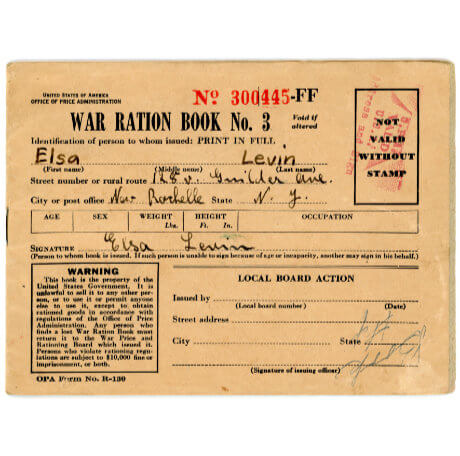
Of course, the rationing that affected daily life the most was food rationing. Ingredients such as sugar, coffee, butter, canned milk, cheese, cooking oil and meat could only be bought via the system of ration books.
Ration books could be acquired by all citizens every month or so, and contained removable stamps. Shoppers could not buy a rationed item without giving the shop owner the appropriate ration stamp for that item. If you were out of ration stamps for that particular ingredient you could not buy it, even if you paid extra.
Millions of men and women went on to serve the country overseas. Leisure activities also declined substantially as people concentrated their efforts on productivity and, the people that remained in the US worked tended to work for longer hours.
Out of fear of air raid attacks, New York started dimming down the lights and perform blackout drills, especially in public spaces.
This was the general mood at the time Hopper painted Nighthawks.
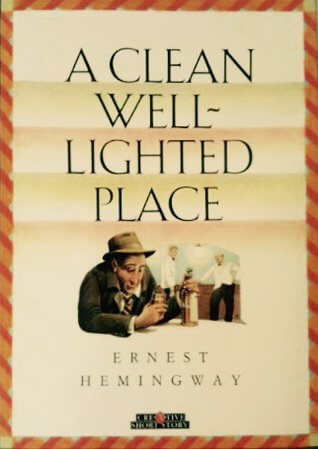
“A Clean, Well-Lighted Place” a short story by Ernest Hemingway
“A Clean, Well-Lighted Place” is short story by Ernest Hemingway that was written sometime in 1933.
The story is set somewhere in Spain. It’s late at night and two waiters (an older and a younger one) in an unnamed café are attending to the only customer left, a deaf old man.
The younger waiter is impatient to go home to his wife, and complains to his colleague that he never manages to get into bed before 3 a.m.. When the customer orders a brandy, the younger waiter gets annoyed and overfills the old man’s glass on purpose.
The older waiter tells the younger waiter that the old man had recently tried to hang himself but was rescued by his niece in the nick of time.
Still, the younger waiter shows little pity, makes nasty ageist comments, and even wishes the old man had succeeded in killing himself.
After the old man asks for another brandy, the younger waiter refuses to serve him anything else and tells him the café is closed. The old man leaves the café, and teeters down the street evidently drunk.
The older waiter is more empathetic towards the old man and disapproves of the younger waiter’s attitude. Like the deaf old man, the old waiter also prefers to stay late at the café, and keeps the café running for as late as possible to ensure that it’s open for whoever needs it.
The younger man interjects, saying that there are bodegas for that purpose, but the older man points out the importance of a clean, pleasant and well-lighted café. Bodegas, according to the older waiter, are not clean, are noisy and customers have to stand – they are not an inviting space.
Moreover, the younger waiter doesn’t seem to understand that even people with money can be lonely. He is young and has confidence and so doesn’t understand the older men’s existential problems.
With no family to come to at the end of the day, the older waiter also feels lonely, and it is this loneliness that makes him aware of the meaninglessness of his life. The older waiter further ponders: how can one alone fight off this nothingness? His lack of confidence thwarts any attempt to actively push the darkness out of his life.
Not even faith helps. This is most obvious when he says, “It was all a nothing and man was a nothing too” and changes the beginning of the popular prayer “Our Father who art in heaven” with “Our nada who art in nada” (nada means nothing in Spanish).
Both the older waiter and the old deaf man are attempting to deal with their own perceived empty life. One strategy to cope with the despair is by seating alone in a clean, well-lighted and pleasant café and drinking until drunk.
The cleanliness and light metaphorically representing the human’s attempt to keep disorder and darkness at bay. The older waiter once says: “I am one of those who like to stay late at the café […] With all those who need a light for the night”. I interpret “a light for the night” as shining some light in an otherwise dark inner world.
Of course, the clean, well-lighted café is only but a temporary reprieve since all cafés eventually close.
The story ends with the older waiter going home after a short stop at a bodega. He mentions that he is probably only suffering from insomnia and that many must have it. Perhaps this is another coping mechanism to alleviate his suffering, blaming the emptiness he’s feeling to a lack of sleep (even though it’s likely the other way round i.e., his depression is disrupting his sleep).
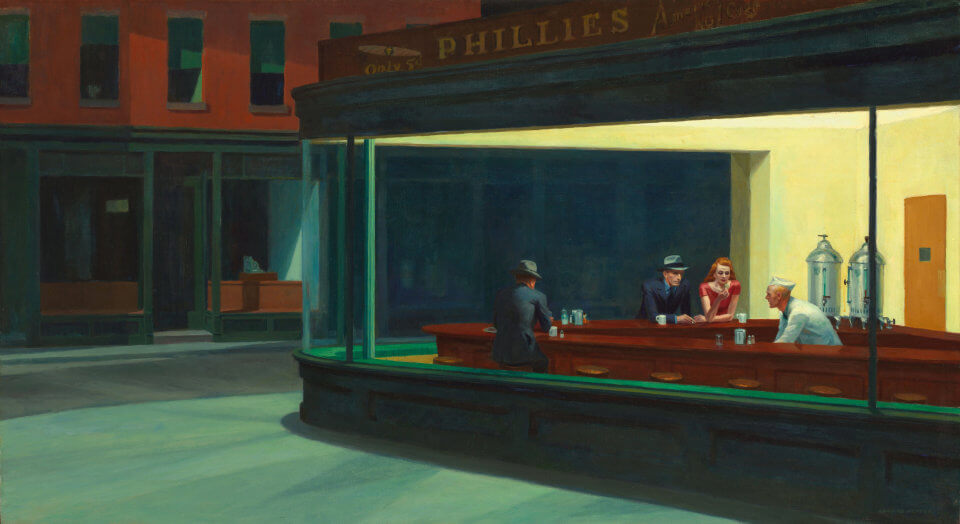
Nighthawks Explained!
For the analysis of Nighthawks, I decided to go over the most salient elements in the painting: the man seating alone, the couple, the barman, the lighting/colours, the diner, and the empty street.
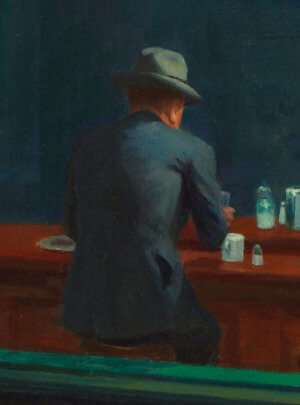
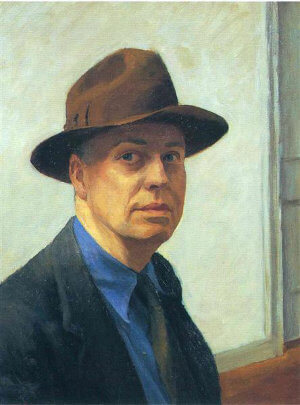
The man seating alone
A close inspection of this figure, one cannot but wonder if this isn’t Hopper himself. Indeed, many of his self-portraits bear striking resemblance with this character (see the self-portrait shown above).
This man holds a newspaper under the arm, which some speculate could be a journal bringing news of the war, even though Hopper didn’t take particularly interest in the ongoing war.
The man appears absorbed in his own thoughts, looking at his glass. There is no attempt (or wish?) to interact with either the waiter or with the couple.
Hopper’s prowess to imbue his paintings with sadness and loneliness couldn’t be more successful with this element really. We cannot see the man’s face, but the curved posture, the slightly tilted head and the lack of companionship surely transpires loneliness.
When I read Hemmingway’s short story “A Clean, Well-Lighted Place” I immediately associated the old man in the story with the lonely man in Hopper’s painting.
In this short story, an old deaf man is also seating alone in a clean and well-lit café at night, drinking. Apparently, the old man is well off, but he attempted suicide out of despair and loneliness (one of the waiters mention that he once had a wife, so perhaps he lives all by himself and does not have children).
Another character in the story, the older waiter, sympathises with the old man’s troubles. He philosophises that life is nothingness, and this realization causes one to despair, particularly as we age and begin to lack confidence.
Hopper was a great admirer of Hemingway, so I do not doubt this short story (which was published 9 years before Nighthawks) somehow found its way into Hopper’s hands.
Hopper was himself an extremely introvert person and had bouts of depression, so it’s not a stretch to imagine that he could have identified himself with the old men’s plight.
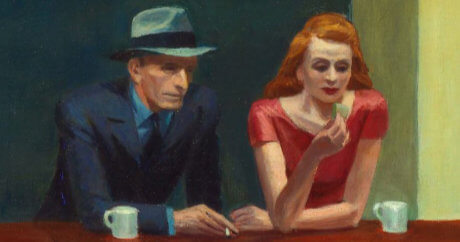
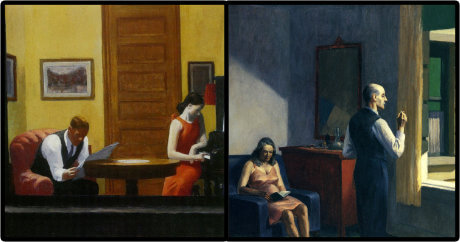
The couple
The man and woman seating next to each other has been a topic of much debate.
If you have seen other of Hopper’s work, you have probably noticed that the couples he often paints are almost never communicating. In fact, they often appear sad, as if entrapped and resigned inside an unhappy relationship.
This is certainly true of Nighthawks. Both the man and the woman aren’t talking to each other. The man is smoking a cigarette while the woman is eating a sandwich, and they are both absorbed in their own thoughts.
About the ubiquitous lack of communication between couples in Hopper’s many paintings, Hopper noted “It’s probably a reflection of my own, if I may say, loneliness. I don’t know. It could be the whole human condition.”
As mentioned earlier, Hopper’s wife, Josephine, seemingly posed for the woman in the red dress. Even though Hopper and Josephine married and remained married until their deaths, their marriage couldn’t be described as a happy one. The couple had often arguments that resulted in silence for days, or worse, developed into actual fights. Hopper failed to support her career, ridiculed her work, and was physically abusive.
It is, therefore, noteworthy that the man seating alone, who might be Hopper himself, is seating at a distance from his wife.
Was Hopper giving us a hint (either consciously or not) about how he saw his relationship with his wife? Close in physical space (in the same diner), but distant emotionally (seated far away from each other)?
Regardless of the answer to that question, it is clear that the couple doesn’t seem very happy either. Some art experts have suggested that they might be strangers, but I find that hard to believe. It’s true that the hands aren’t touching, but they are “almost” touching, which kind of suggests they may at least know each other. Also, for a fairly empty diner, there would be no reason to sit so close to each other, especially since the entrance appears to be situated on the opposite side of the diner.
Note that the man with the beaked nose was apparently also modelled around Hopper (according to Josephine’s annotations, the shape of the man’s nose led Josephine to name the painting “Nighthawks”), although I do not find the physiognomy to be very close to Hopper’s facial features (although the same could be said of the woman and Josephine). Due to the almost inexistence of male or female models, Hopper probably resorted to painting men based on his figure, but it’s likely the beaked-nose man is intended to be a stranger.
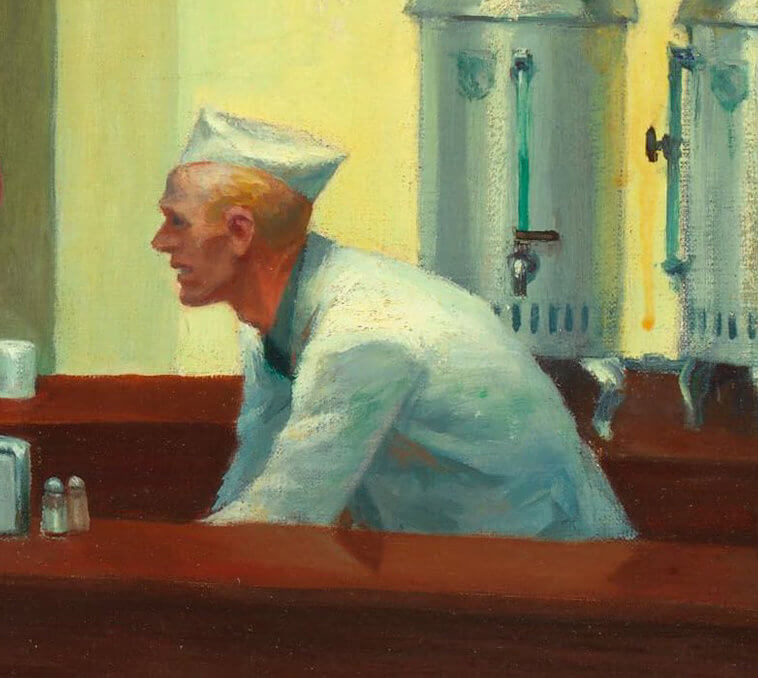
The waiter
Not many analyses of this painting have much to say about the waiter. He is busy doing something under the counter – perhaps cleaning, perhaps preparing another drink.
At first glance, it looks like he is conversing with the beaked-nose man, but it isn’t clear if he is looking directly at him. Closer inspection reveals a facial expression of a certain apprehension as well.
So, and contrary to Hemingway’s short story, not even the young waiter seems to escape this sense of alienation that is pervasive in all the diner’s occupants.
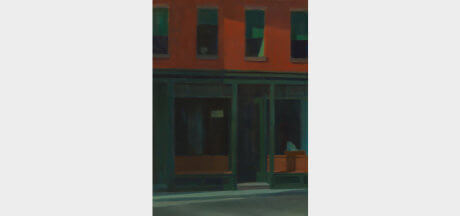
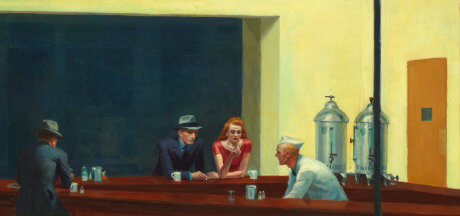
Light and colour
The lighting inside the diner was inspired by the novel neon lights, introduced in the US in the 1940s.
Hopper was obsessed with light and studied it with great care. He was particularly attentive at how light reflected off people and buildings. The deeply observant Hopper once said: “As a child I felt that the light on the upper part of a home was different from that on the lower part. There is a sort of elation about sunlight on the upper part of a house.”
Hopper’s close study of light and colour and its application on Nighthawks is one crucial aspect of the painting that gives this piece it’s eerie vibe.
Yellow is a colour that quickly grabs your attention, and I think this is exactly what Hopper intended – that our gaze shifts immediately to the interior of the diner.
In addition, being a very bright and warm colour, it stands in stark contrast to the more washed out tones outside the diner, further accentuating the duality between alive and nothingness. In fact, the only vestige of brightness in the outside street comes from the lights emanating from the inside of diner.
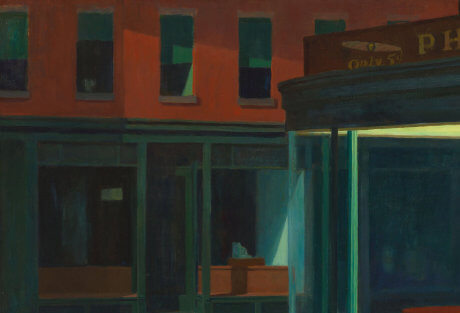

The diner
Because Hopper spent most of his life in Greenwich village, New York, many have speculated that the diner was situated somewhere there. Indeed, the brick buildings on the street do resemble of buildings that dot the village here and there (see figure above). However, most art experts have concluded that Hopper didn’t base the diner on any actual physical diner.
It’s more likely that the diner is simply a composite of some kind, as Hopper once famously said that most of his paintings are not taken from any particular scene, but are rather composites.
The diner is superbly cleaned, which, again, brings to mind Hemingway’s short story “A Clean, Well-Lighted Place”.
In the story, the older waiter makes a comment that the old man drinks without spilling, even drunk, so he doesn’t really make a mess in the café. The waiter goes on talking about the importance of having a clean, well-lit, and pleasant café, for people to come into in times of need. Such a café is, according to the waiter, a space where lonely individuals can deal with their despair and drink themselves unconscious, enabling a temporary reprieve from all the emptiness they harbour.
This is undoubtedly the feeling Hopper’s diner transpires. It is clean, well-lit, and pleasant. The old man seating alone is even drinking something (I’d be tempted to say brandy, as that was what the old deaf man was drinking in Hemingway’s short story, but the glass the man is holding in the painting doesn’t appear to be a snifter).
Based on the empty coffee tureens, it’s safe to assume it is very late at night. Maybe, as with the older waiter, the three patrons suffer from insomnia and came to the diner for a bit of light to shine over their melancholy. What best place to drown one’s sorrows than a well-lighted and clean diner?
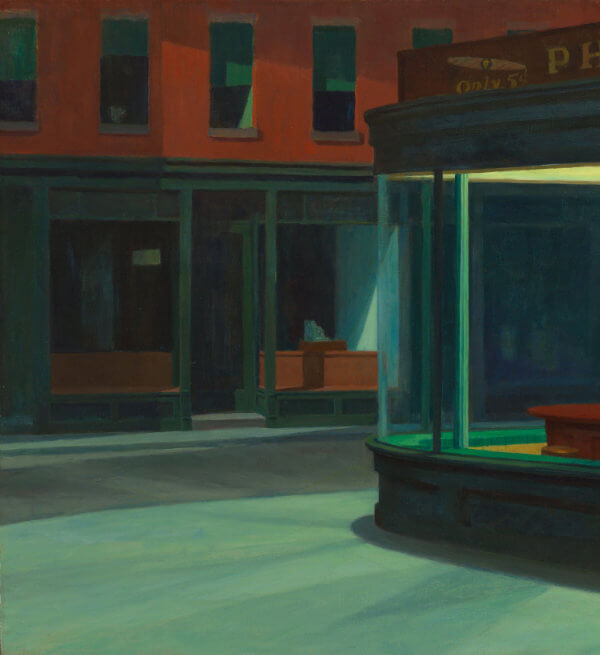
The outside street
Contrary to the inside of the diner, the outside street is devoid of life. There are no passers-by and the only visible shop window is completely empty except a cash register, as if the shop were out of business. The flats above the empty shop are all dark – no lights – probably suggesting that they too are uninhabited.
Note how Hopper deliberately chose not to include a single element outside the diner that may be suggestive of some continuance of life. For example, he could have placed a parked motorbike, a single lit lamp in one of the flats, a person looking out of a window, a bird, a stray dog passing by, hell, even dog poo on the pavement.
But, there is nothing.
With it, Hopper wants to accentuate this divide between emptiness (nothingness) and life.
Coming back to Hemingway’s short story, the inner worlds of both older men are permeated by emptiness.
So, perhaps the outside darker street is a representation of this nothingness that most of us are likely to feel at some point, whereas the well-lighted diner is the refuge that makes that nothingness more bearable.
Conclusion
Nighthawks brilliantly depicts human loneliness in a place (New York) that, paradoxically, is the most populated city in the US.
Note, however, that Hopper never explicitly gave meaning to this painting, although he acknowledged that unconsciously he might have painted the loneliness of a large city.
The painting was completed in the midst of the second world war, at a time when the mood in New York city was one of anxiety and mistrust. The focus on the war effort and the sacrifices it required (rationing, cut on spending, blackout drills, etc.) meant a decrease in socializing, and, consequently, more desolate and lonely places. Nighthawks captures this solitude magnificently.
But Nighthawks shows another side – a brighter (though not necessarily happy) side. Perhaps influenced by Hemingway’s short story “A Clean, Well-Lighted Place”, the well-lit and clean diner could be viewed as a refuge for warding off loneliness; a place which is always present, always available for those of us, tormented souls, unable to sleep at night.
Hopper’s combination of lighting and colours brings to the fore the stark contrast between the alive (interior of the diner) and nothingness (outside the diner).
Although no customer appears happy inside the diner, the prospect of coming out (into nothingness) is, I guess, more foreboding.
Perhaps that is the reason why the diner in Nighthawks has no entrance door. To me, that represents a glimpse of hope that we might not be entirely alone in the combat against nothingness. After all, there is always a clean, well-lit diner around the corner.
The older men in “A Clean, Well-Lighted Place” would have surely welcomed it.
Final thoughts
Whether Nighthawks should be interpreted as a work depicting human isolation is open for debate.
It is true that Hopper alluded to the idea that Nighthawks portrayed the loneliness of a large, urban city but, as I mentioned above, he never really gave any explicit meaning to this painting.
I try to shy away from overinterpreting artworks, but in the case of Nighthawks, Hopper clearly wished the viewer to come up with his/her own narrative.
And how clever it was of Hopper to choose a mundane scene such as this, which we can all surely relate to. After all, haven’t we all, at some point, felt comfort in seating alone at a cozy café and contemplate life?
I sure have.
See you in the next article!


